Xavi’s arrival at Barcelona seems to have reinvigorated the team. They’re displaying a more dominant style, dominating possession and pressing higher and better, showing something closer to their golden years with Xavi as a player. However, they’re lacking goals with Memphis Depay not performing at a top-level (he’s not an out and out striker), Luuk De Jong not trusted by Xavi and Kun Agüero out. Only Ansu Fati seems a reliable finisher but putting all the pressure on a 19-year-old kid who has just recovered from a 10-month injury seems a very risky decision.
That’s why Barcelona are looking for a striker. Their precarious financial situation greatly limits what they can do in the January market so some creative options are emerging as their top targets. The one that has been most strongly linked to them is Arthur Cabral, a 23-year-old Brazilian striker who plays for Basel in the Swiss Super League.
Cabral started his career at Ceará in Brazil. After 29 goals in 81 games there, Palmeiras signed him for a million euros but he stayed just six months (1 goal in 5 games) before signing for Basel first on loan and then permanently for 6 million euros. Since he arrived in Switzerland, he has played 100 games, scored 62 goals and provided 17 assists, becoming the star of the Swiss Super League.
With 24 goals and 8 assists in 25 games this season, Cabral has been phenomenal this start of the season. His role as a big number nine who can hold the ball, put his teammates into play and then dominate in the box is the profile Barcelona seem to be looking for. At just 23 and having recently been called to the Brazil squad, he’s one of the hottest commodities in Europe at the moment.
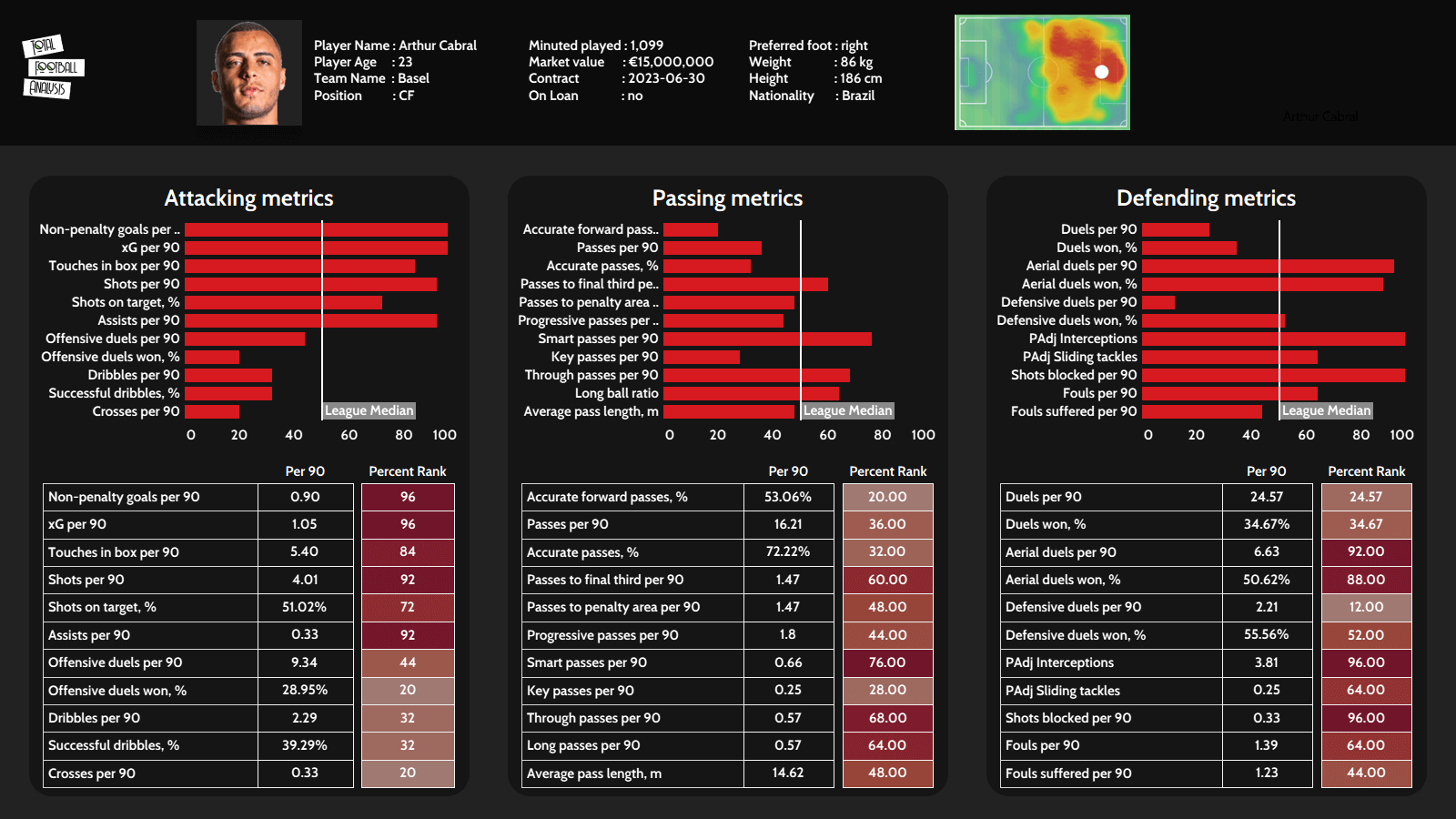
In this data analysis, we have used our exclusive xGOLD tool to find four players statistically similar to Arthur Cabral (data profile above) who are approaching young (under 23 years old) and who wouldn’t cost too much for Barcelona (valued at 8 million euros or less on transfermarkt). The analysis of the best five results with similar statistics to Cabral’s is presented here.
All the radars in this data analysis show the percentiles comparing each player to the rest of the strikers in their league. For example, a higher value on shots per 90 doesn’t mean that player takes more shots, it means he takes more shots than a higher percentage of strikers in his league. We must take into account the difference in level when interpreting the radars as it isn’t the same to perform in the Swiss Super League, the Argentinian Primera División, the MLS or the Bundesliga.
Valentín Castellanos – 23, New York City – 92% similarity
Castellanos (1998, 1.79m / 5’10’’) is an Argentinian striker who started his career in Chile, playing at academy level for Universidad de Chile before being taken by the City Football Group to play for Torque City in Uruguay. In a year at Torque, he played 30 games and scored five goals, moving up the ladder in the City Football Group and joining New York City in the MLS.
Since he arrived in the USA, Castellanos has scored 40 goals and provided 18 assists in 107 games. In the 2021 season, he was the top scorer in the MLS with 19 goals, showing he’s ready for the next level. He has played six games with Argentina U23 in the Olympics qualification phase too.
Besoccer values him at 11.7 million euros based on his performance and transfermarkt, at 7 million euros, so he seems to be an undervalued player given his performances.
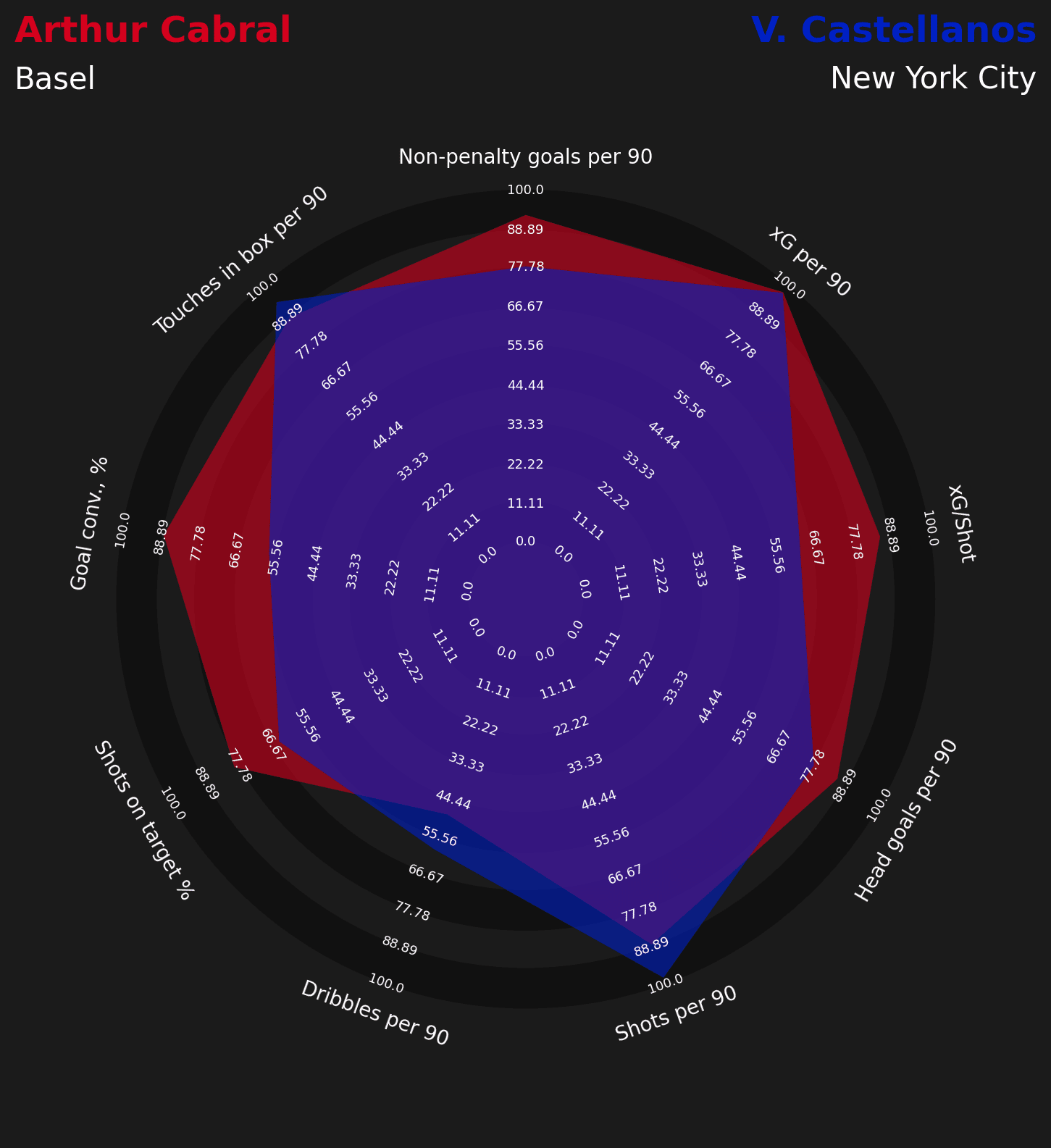
The offensive radar shows how similar Cabral and Castellanos are. They’re very close in most metrics, with the main difference being that Castellanos takes more shots (3.81 per 90) but from worse positions (0.17 xG per shot) compared to the strikers in the MLS, consequently ranking lower at shots on target (47.3%) and conversion rate (15.5%), which translate into scoring more compared to the players in his league too (0.49 non-penalty goals from 0.52 non-penalty xG). Castellanos dribbles a little bit more (3.19 dribbles per 90) and has slightly more touches in the box too (4.82 per 90).
Castellanos is very quick in short spaces to play 1-2s or make intense short runs in behind between the centre-back and the full-back. He’s always focused on making these movements towards the goal and getting into scoring positions. Good jump to contest headers and great heading technique. Ready to poach goals at the far post and very difficult to mark in set pieces. Very calm when he faces the goalkeeper, knows when he has time to control the ball and advance or when he needs to finish quickly. Quality finisher, places his shots far from the goalkeeper using both feet and has also scored some nice goals from the edge of the box. Has missed some chances because of his calmness but the quality is there and he’s performing close to the expected.
He’s just ok at dribbling, his technique is good but nothing special. Better at getting chances with his off-the-ball movements than at creating them by and for himself.
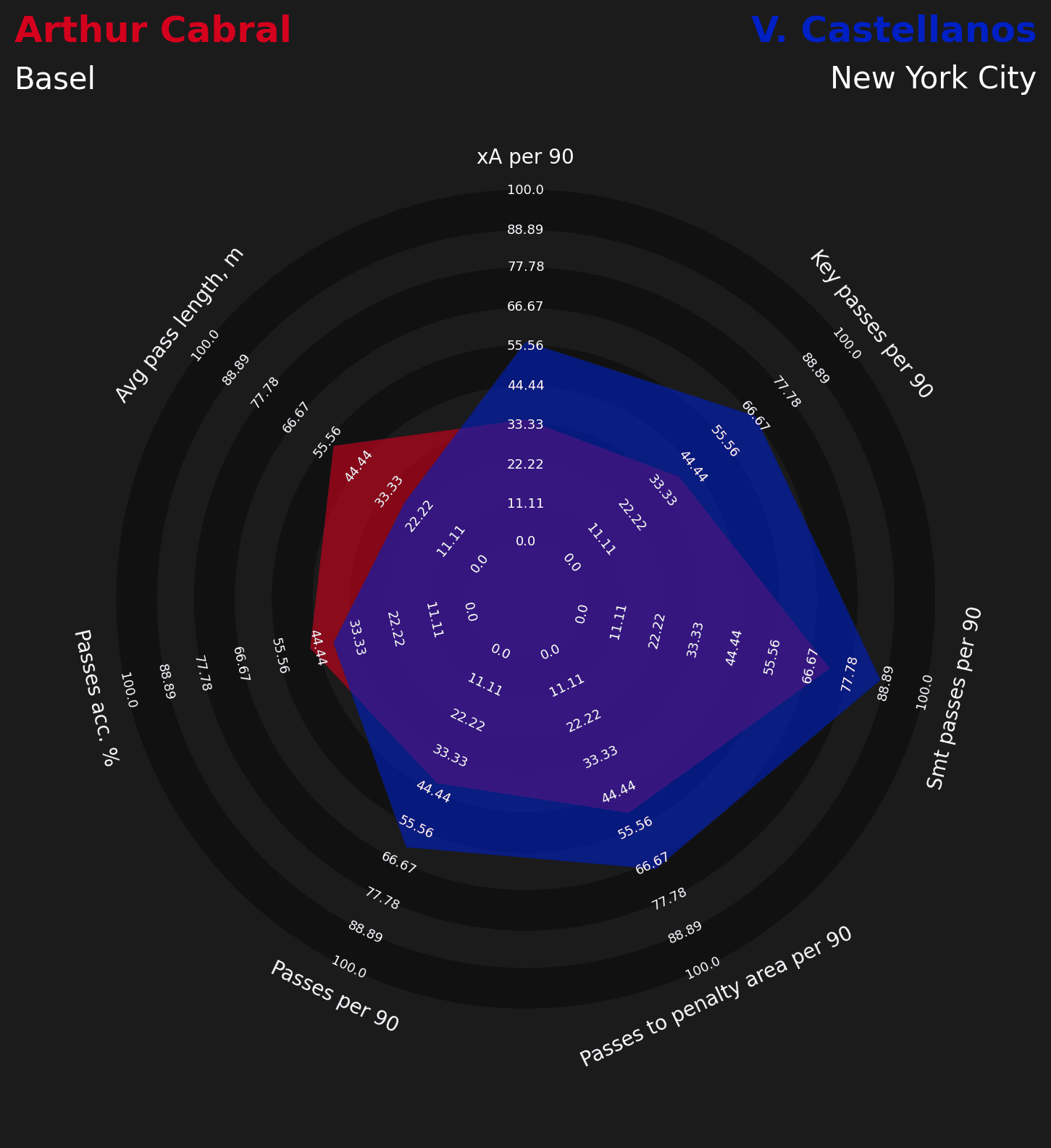
Castellanos has better passing statistics but isn’t a standout striker in the MLS anyway. He’s ranked higher than Cabral in most metrics, showing he has some ability to assist (0.1 xA per 90) and get the ball into dangerous positions (0.44 key passes per 90) but both of them are strikers who aren’t too involved in the game and more focused on finishing the attacks.
His passing quality is just ok, he can drop deep or drift wide to help his team in transitions but focuses most of his game in central areas of the final third. Can also combine close to the box and his movements create space for these combinations to happen. Could do better with his back to the goal as he’s not very strong and loses some balls or misses passes when marked tightly. He’s very confident and likes to showboat and attempt rabona and backheel passes that provoke rivals even when not successful.
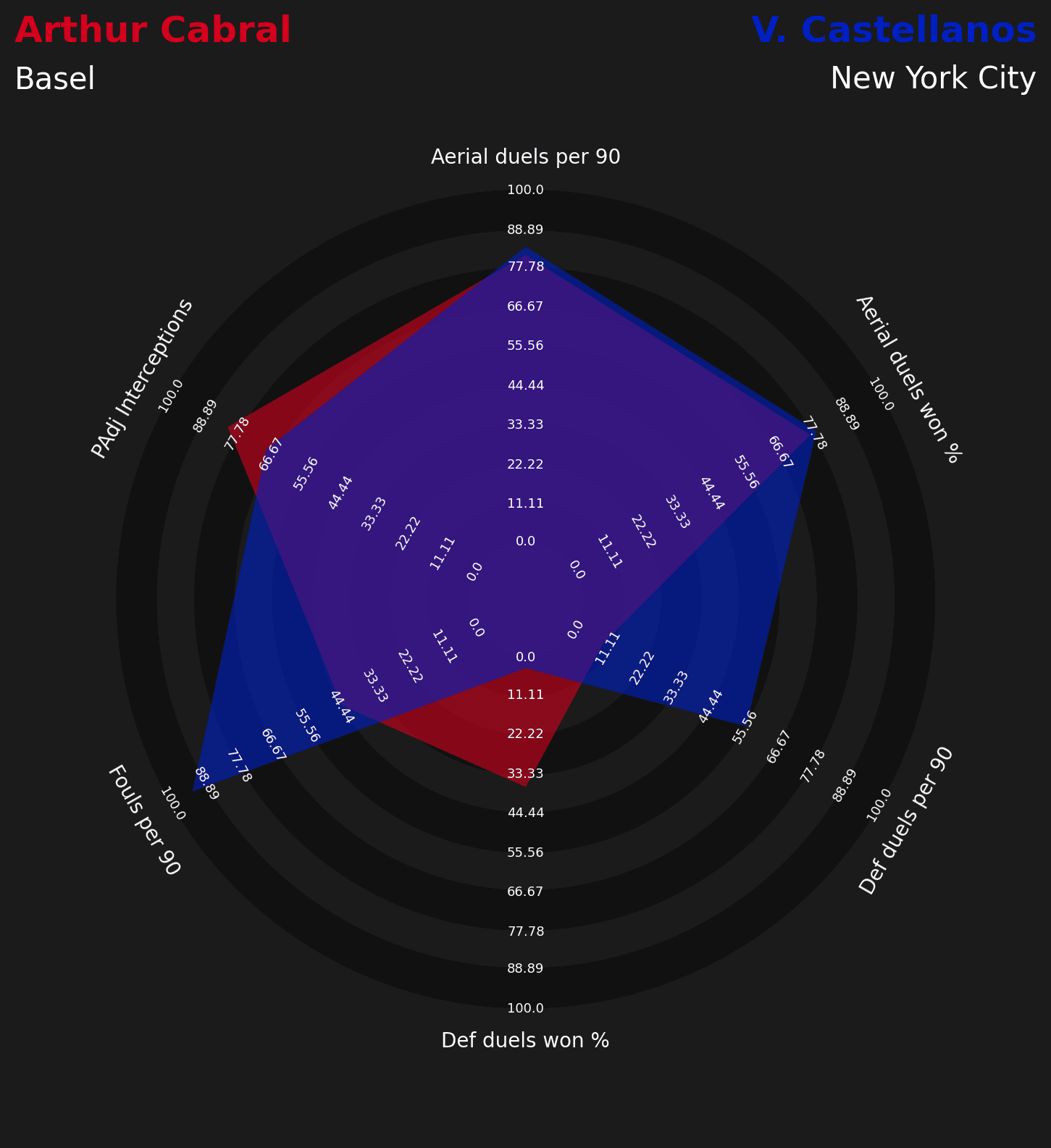
In defence, both of them do well in the air, raking in the top quartile both for aerial duels per 90 (7.62 for Castellanos) and success rate (44.19%) in their leagues. Castellanos gets into more defensive duels (3.96 per 90) and this makes him commit more fouls, probably because of his team’s tactics, but Cabral wins a higher percentage of his duels. Their positioning to intercept passes is quite similar once possession-adjusted, with Cabral being slightly better ranked.
Castellanos is aggressive and intense in defence. Well-positioned to immediately transition into attack after his team recovers the ball, he’s always ready to capitalize on any mistake the rivals make.
The MLS top scorer would provide Barcelona with the much-needed movement in the final third to unlock all the passing quality they have. Despite not being tall, he’s a very good target for crosses and a decent player with his back to the goal. However, he may lack some quality to play far from the goal and combine so he would need an adaptation period or to focus even more his game on scoring instead of dropping between the lines.
José Manuel López – 20, Lanús – 90% similarity
López (2000, 1.88m / 6’2’’) is another Argentinian striker who has played for Lanús in Argentina since he was 16. He has played just 36 games for the first team, scoring 13 goals (12 of them in the 2021 season). At the moment of writing, he’s the third-top scorer in the Argentinian Liga de Fútbol Profesional.
Besoccer values him at 6.3 million euros and transfermarkt at 8 million euros. It seems like his potential has more influence on his value than his performances so far.
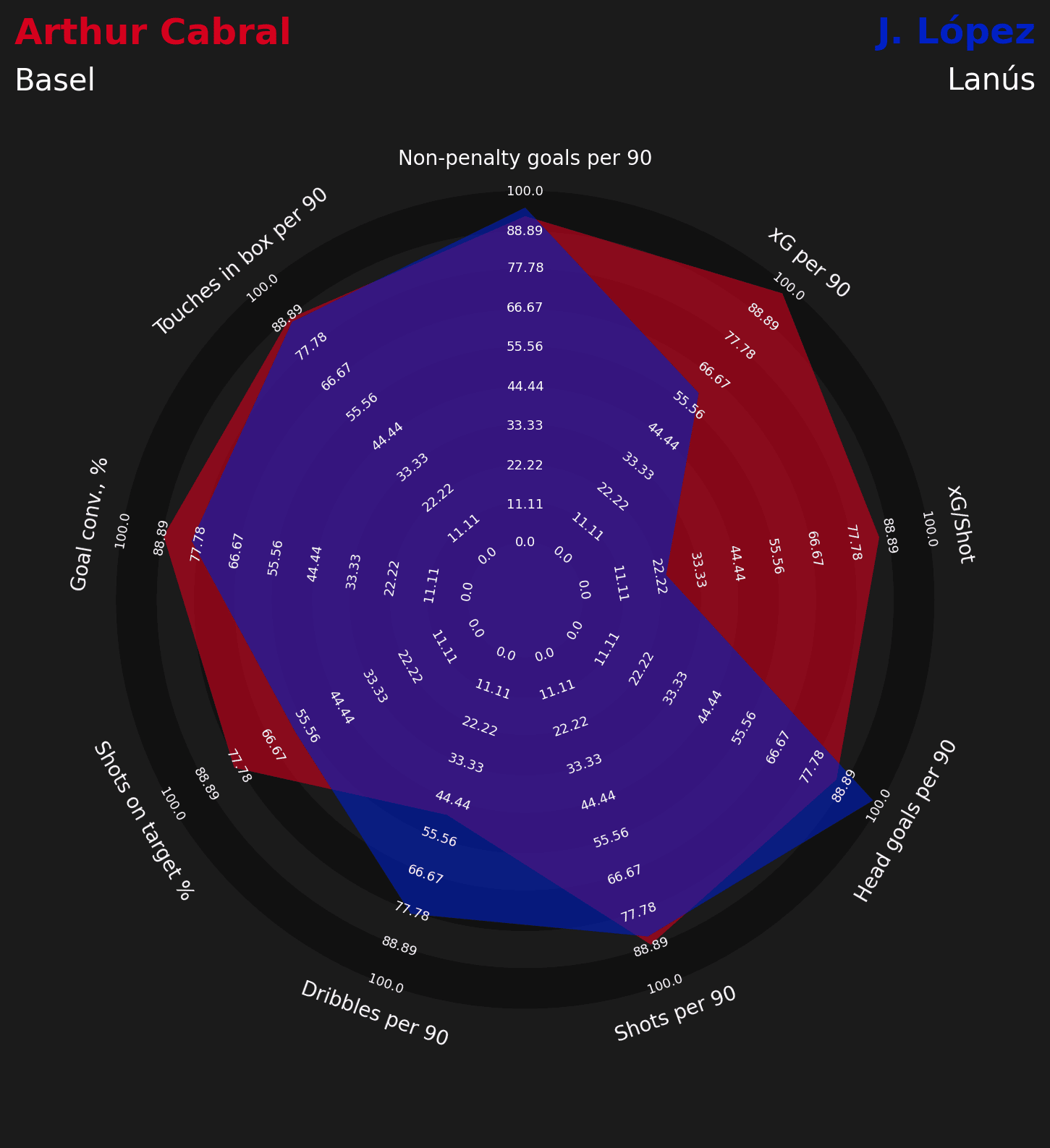
López and Cabral are very similar in terms of shots (2.33 per 90), touches in the box (3.56 per 90) and non-penalty goals (0.55 per 90) when compared to their fellow strikers in their leagues. It seems like López is going through a sweet period in front of goal as he’s scoring more than expected as he doesn’t rank particularly high in xG (0.3 per 90) or xG per shot (0.13). He has some more tendency to dribble than Cabral (4.06 dribbles per 90) and really stands out for his head goals too (0.32 head goals per 90).
He creates separation before crosses come and then attacks them using his power and size to win the aerial and score. Also uses that separation to receive free at the edge of the box and take advantage of his great shot from distance. Excellent in the air, excels in set-pieces and is a great target for crosses. A fantastic finisher, his shots are very powerful and accurate. Still misses some easy chances, his long efforts make him overperform his xG but with a small and natural improvement, he could add these easy goals to make his record even more impressive.
He has enough pace to run in behind and drag defenders with him. Most of his dribbles come when he’s protecting the ball and he does well to escape pressure in those situations but doesn’t have the explosiveness to get past his man in 1v1 situations.
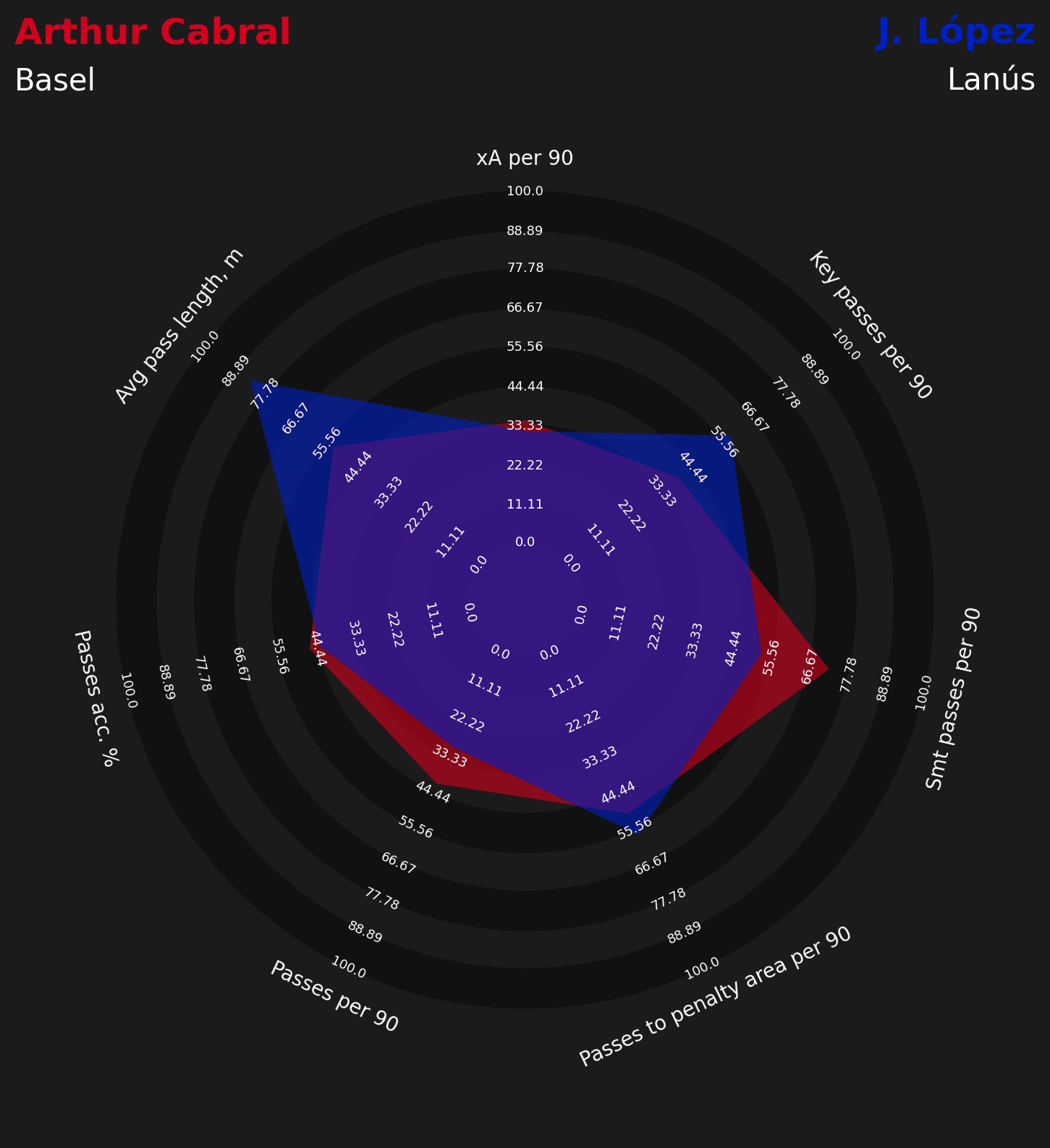
Looking at their passing metrics, López tends to play longer passes and creates more chances as we see in his above-average key passes (0.32 per 90). Both players aren’t involved a lot in the attacks or are expected to assist too much (0.05 xA per 90), focusing their game more in the box.
López has good technique to play with his back to the goal. Manipulates the ball well while holding the ball to create space and time for his teammates to arrive and creates chances by playing well-timed layoffs too. He also has some quality details with his left foot but still not as consistently enough to consider him a quality passer.
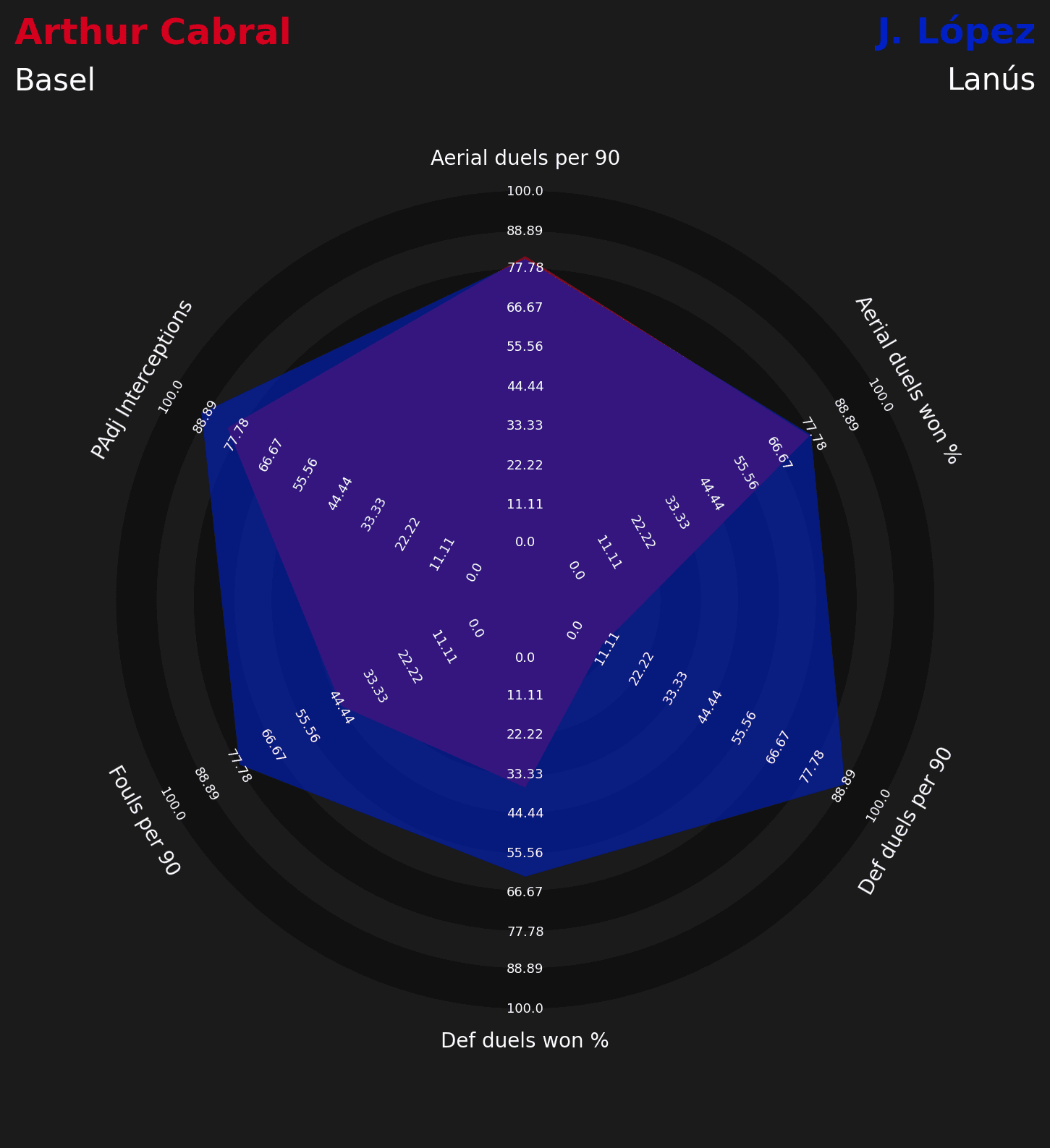
Defensively, López looks better than Cabral. He contests and wins more defensive duels (wins 53.78% of his 5.43 defensive duels per 90), has slightly more possession-adjusted interceptions (4.08 per 90) and is practically the same in the air when we compare this data to the strikers in each player’s league (wins 40.18% of his 10.22 aerials per 90).
With a lot of defensive responsibility as he pairs upfront with José Sand, who is 40 and the top scorer in the league, López needs to do the work of two players. He drops deep to mark the rival defensive midfielder when Lanús defend in a low block and is strong and aggressive in duels.
Taking him, Barcelona would get more presence and size upfront and someone who can hold the ball and be the target for crosses, a profile they only have in Luuk De Jong. The Dutch striker is on loan and not trusted by Xavi so a younger alternative who can develop into a better player can be a good alternative. López would also add some threat from distance, another of the weak points in Barcelona’s squads over the seasons. However, he’s not especially fast and would need some adaptation time to combine in tight spaces alongside highly technical players so it’s unlikely that he would perform from the first moment. Could be an interesting option to move between the B and the first team until he adapts and is ready to play in La Liga.
Jonathan Burkardt – 21, Mainz 05 – 89% similarity
Burkardt (2000, 1.83m / 6’0’’) is a German striker who has always played for Mainz 05. He has been a great goalscorer in every age group with 9 goals in 30 games for the U17 team and 21 in 35 for the U19. For Mainz 05’s first team, Burkardt has already played 58 games, scoring 12 goals. It’s in the current season when Burkardt has excelled, scoring 9 goals in 14 games so far. He has also played for Germany at every age group from U15 to U21, where he’s currently the captain. He has 14 goals in 30 games for the different youth national teams.
Transfermarkt values him at just 6.5 million euros but Besoccer thinks he’s worth 22.1 million euros based on his performances so he seems someone who’s not getting all the attention he deserves and could be a bargain.
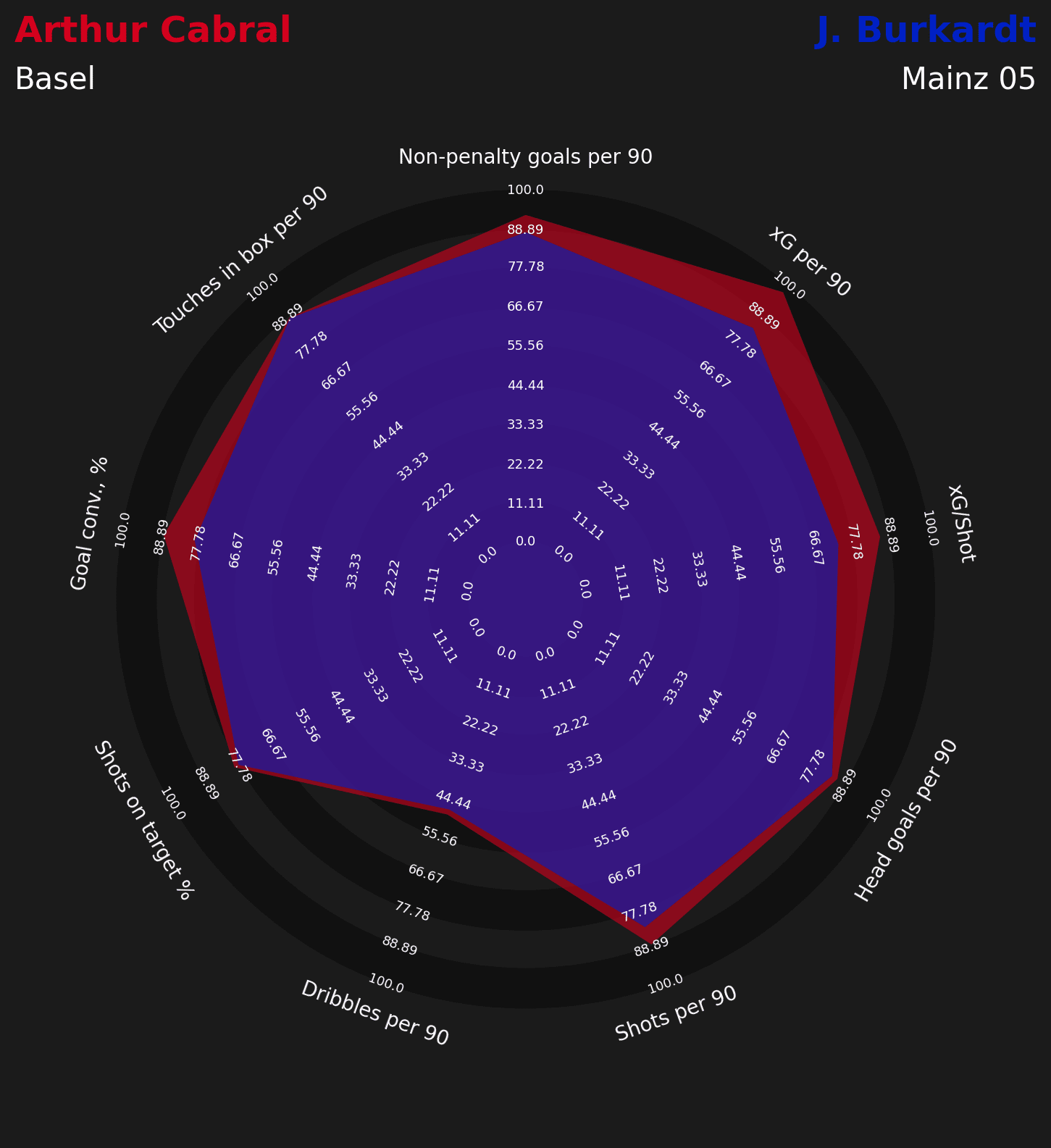
The offensive profile of Cabral and Burkardt is practically the same. Burkardt ranks slightly lower in all metrics but considering he’s compared to the strikers in the Bundesliga and Cabral to those in the Swiss Super League, Burkardt looks like a top profile.
He shoots a lot from good positions (2.36 shots per 90, 0.16 xG per shot), has a high conversion rate (24%), is very active in the box (4.15 touches in the box per 90) and also scores a lot with his head. A pure number nine, he doesn’t dribble too much (3.02 dribbles per 90) and is in charge of finishing the attacks. All this leads to him scoring 0.57 goals from 0.37 xG per 90.
Burkardt makes very good runs in behind, has pace and finds spaces between the centre-back and the full-back. He’s intelligent in the box, often changes directions to send his marker the wrong way, creates separation to receive cutbacks and attacks the near or the far post depending on the play so he’s unpredictable. Strong to resist challenges while running, defenders find it difficult to stop him.
Once inside the box he can dribble and create space for his shots. Capable of finishing accurately with either foot, he doesn’t mind cutting into his left foot if that’s the best solution and remains calm in 1v1 situations to place the ball far from the goalkeeper’s reach. Good heading despite not being especially tall, anticipates and has good strength and jump to win the position.
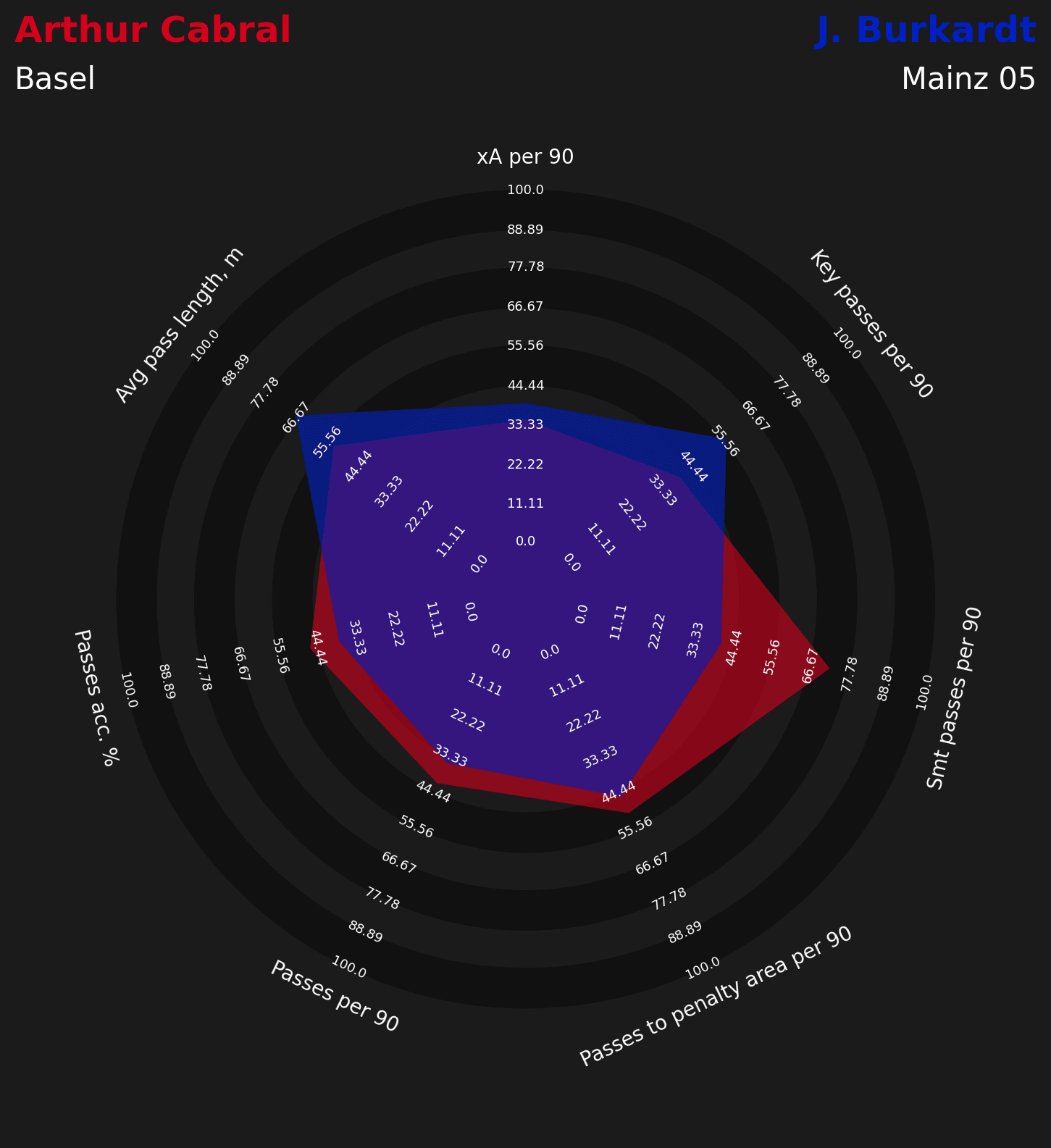
In terms of passing, Burkardt creates more and better chances (0.47 key passes and 0.05 xA per 90) as he usually gets the ball close to the box. He’s even less involved than Cabral in the attacks (just 16.49 passes per 90) and both of them rank in the bottom half for most of the selected metrics. Anyway, neither of them are creative forces.
He has good hold-up play and some ability to create chances with layoffs when he’s around the box. His technique is good to combine and has quick movements in tight spaces but stays mostly in very advanced positions hoping to receive balls in behind and score instead of dropping deep and playing between the lines.
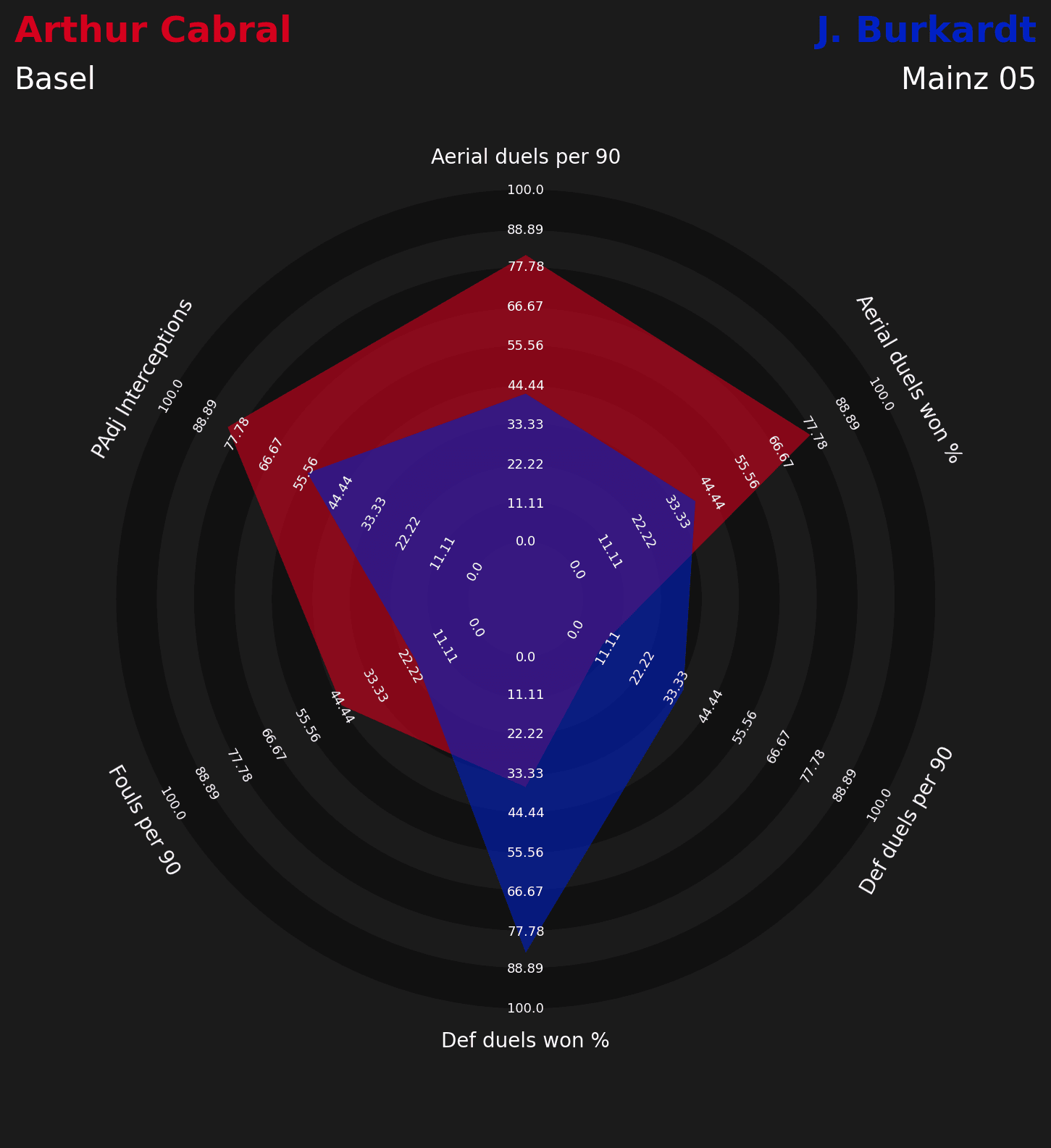
In defence, both players show more differences. Burkardt is worse in the air both in quantity (4.34 aerials per 90) and success rate (28.26%) and his positioning to intercept passes is also worse (2.34 possession-adjusted interceptions per 90). However, Burkardt works hard, gets into more duels (3.3 defensive duels per 90) and is very good in them, ranking in the top quartile for success rate in defensive duels (62.86%).
Burkardt does well in aerial duels in the box because he’s lively and has good anticipation but doesn’t have the size to be a target man and receive direct play. He works hard in defence and his strong legs help him win a very high percentage of his defensive duels.
With Burkardt, Barcelona would get a very energetic striker who guarantees movements in the final third and creates passing options and spaces for his teammates. He’s also a good presence if they decide to cross the ball and is an instinctive finisher who has proven he can score at the highest level. Looking at the strikers Mainz have sold in recent years (Jhon Córdoba, Shinji Okazaki, Yoshinori Muto), we could expect a fee between 10-20 million euros so he wouldn’t be much cheaper than Cabral. However, he’s proven at a higher level, younger and doesn’t need to occupy one of the non-EU spots so the high fee would be justified.
Luis Vázquez – 20, Boca Juniors – 87% similarity
Vázquez (2001, 1.90m / 6’3’’) is the third Argentinian striker on our list. He played at the academy level for Patronato before joining Boca in July 2020. His outstanding performances for Boca’s reserve team (18 goals in 29 games) earned him a position in the first team, where he has played 27 games and scored 7 goals so far. In the last couple of months, he’s been a regular starter and has been called by the Argentina U20 team.
He’s valued at just 1.8 million euros by transfermarkt and Besoccer hasn’t assigned him a value yet as he hasn’t played enough first-team minutes so any team acting now could anticipate the competition and get him before his price increases.
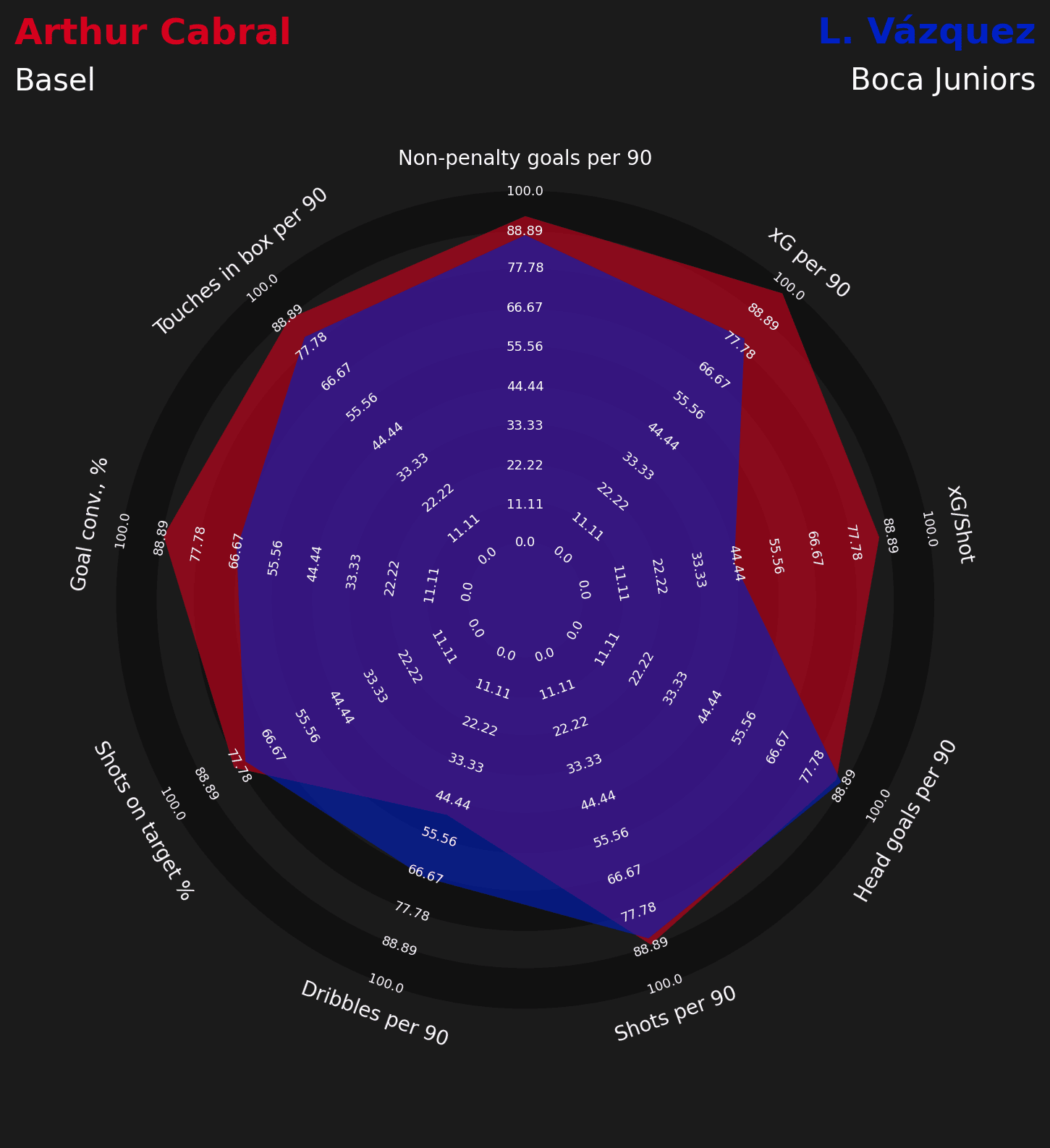
Despite the similar profile in attack, Vázquez and Cabral have some differences. Vázquez takes more speculative shots (0.14 xG per shot), which explains his lower conversion rate (16.2%) and xG (0.42 xG per 90). He also dribbles slightly more than Cabral but the difference isn’t too big (3.38 dribbles per 90). He’s scoring at a slightly higher rate than expected with 0.47 non-penalty goals per 90.
Dominant in the air, Vázquez is a great threat when his team crosses as his jump and heading technique are excellent apart from his size. He takes shots every time there’s a chance, often from far when he could pass the ball. He also shows some quality details to feint and dribble in the box before shooting. His shots are very powerful but he lacks some quality to finish when he needs it. Given his size, Vázquez has a quite good pace in open spaces and could be a threat in quick transitions too.
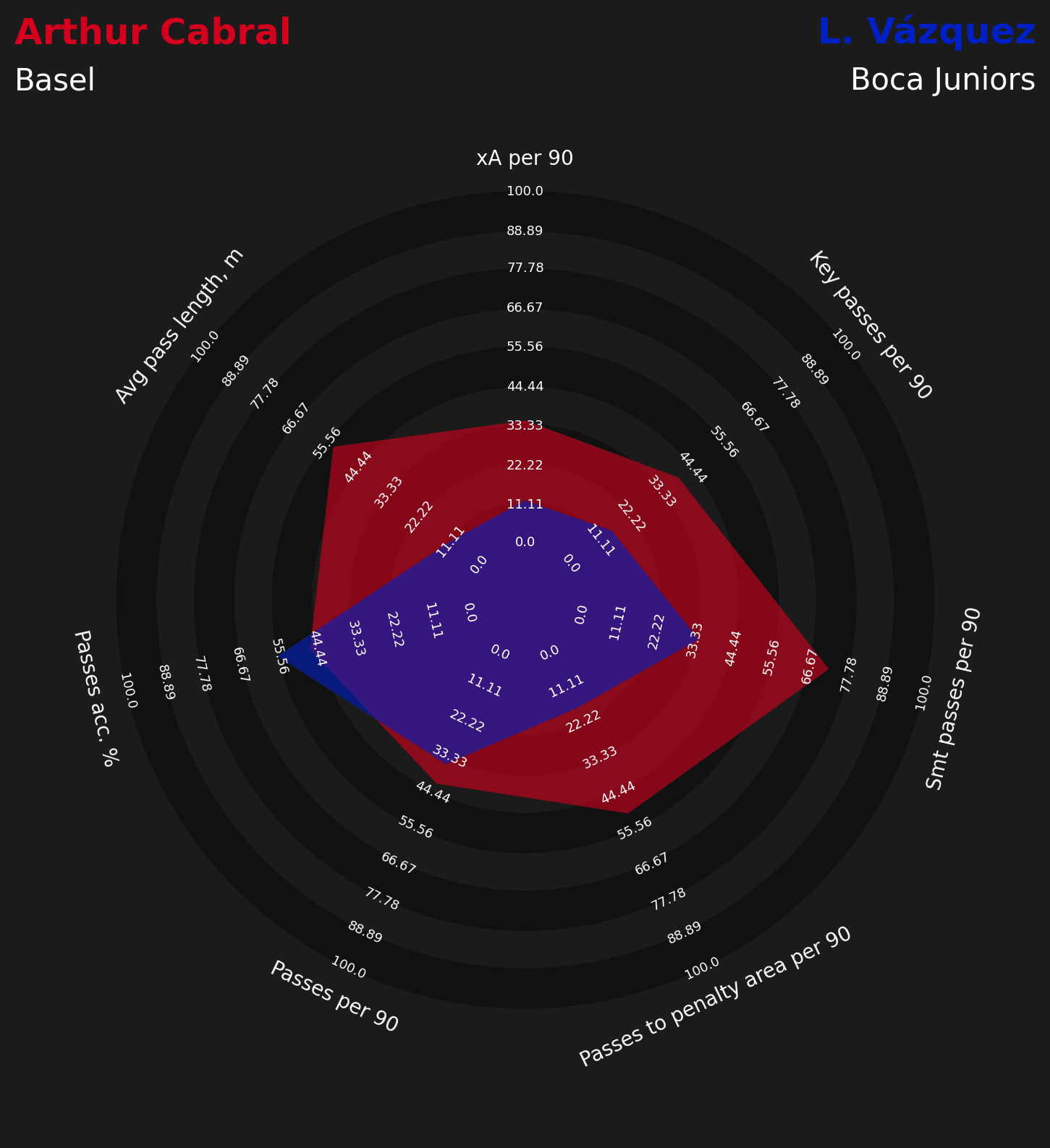
The passing profile has more differences. Vázquez ranks very low in most statistics, with his data showing he almost doesn’t get involved in the attacks (just 9.44 passes per 90) and almost doesn’t create any chances (0.08 key passes and less than 0.01 xA per 90), being totally focused on finishing the attacks. His high passing accuracy (72.64%) is interesting as it shows he probably plays simple passes to nearby teammates to keep the attacks fluid.
Vázquez is a very strong striker who’s often used as a target man for his team’s build-up. Apart from this role, he rarely gets on the ball as he tends to wait in the box, where his power makes him dominate much older defenders. His technique is good to bring the ball down and doesn’t overcomplicate things, giving the ball to more able teammates before returning to an advanced position. When he receives closer to the box, he still keeps a high passing accuracy but doesn’t have the quality to create chances with layoffs or quick 1-2s.
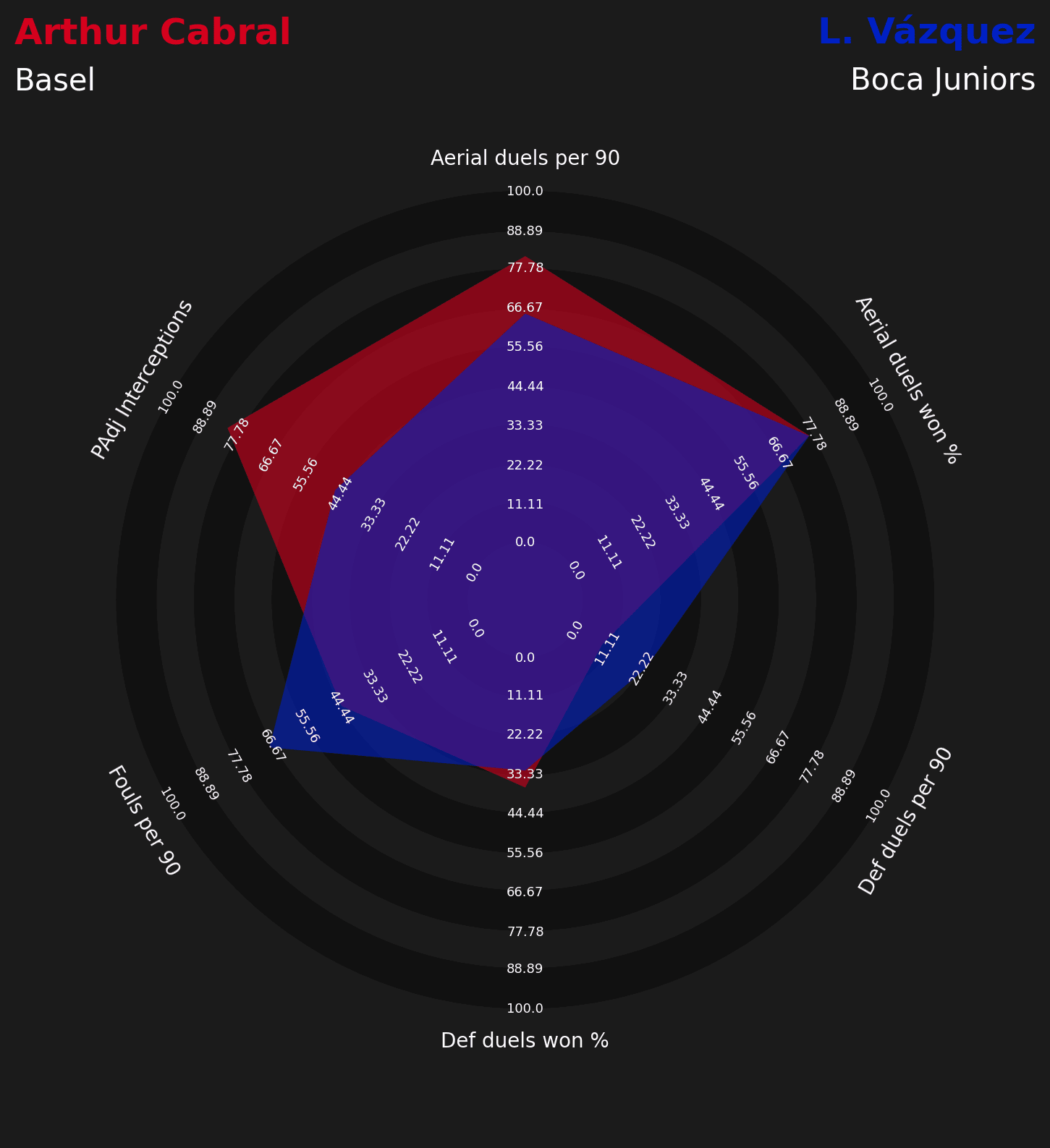
In defence, both of them are good in the air (wins 41.38% of his 6.84 aerials per 90), aren’t very involved in defensive duels (2.36 per 90) as they play for dominating teams but Vázquez is much worse in his defensive positioning as we can see in his 2.16 possession-adjusted interceptions per 90.
Vázquez is dominant in the air, which also helps in defensive set-pieces, and aggressive in duels. He often angers rival defenders as he doesn’t shy off challenges and has the physicality to fight with anyone.
Compared to Boca legend Martín Palermo as a very physical and effective scorer, Vázquez isn’t the profile one would expect from a Barcelona player as he’s not especially fine and technical. However, as La Masía struggles to produce strikers, a different profile who can dominate the box and transform all the attacking flow Barcelona create into goals could be a very valuable asset. Same as López, he would take Luuk De Jong’s role but is eleven years younger and able to play for Barça B while he adapts so there’s a higher future value and still a lot of room to improve too.
Ricardo Pepi – 18, Dallas – 87% similarity
The last player on our list is Pepi (1998, 1.85m / 6’1’’), who has American and Mexican passports. Pepi is a product of Dallas’ academy. He started playing for North Texas SC (Dallas reserve team) in the USL1, scoring 11 goals in 14 games aged just 16. He’s also been a regular part of the first team since he was 16 and has played 59 times so far, scoring 16 goals.
His fantastic 2021 season (13 goals in 31 games) have earned him a call-up for the USMNT, having played the last six games and scoring three goals in the meantime. Previously, he played for the U17 and U16 teams of the USA and before, for Mexico U16. To put it into context, he has scored more goals than Gonzalo Higuaín and Nani this season in the MLS.
Transfermarkt values Pepi at 8 million euros and Besoccer at 6.3. Again, the market is anticipating his potential.
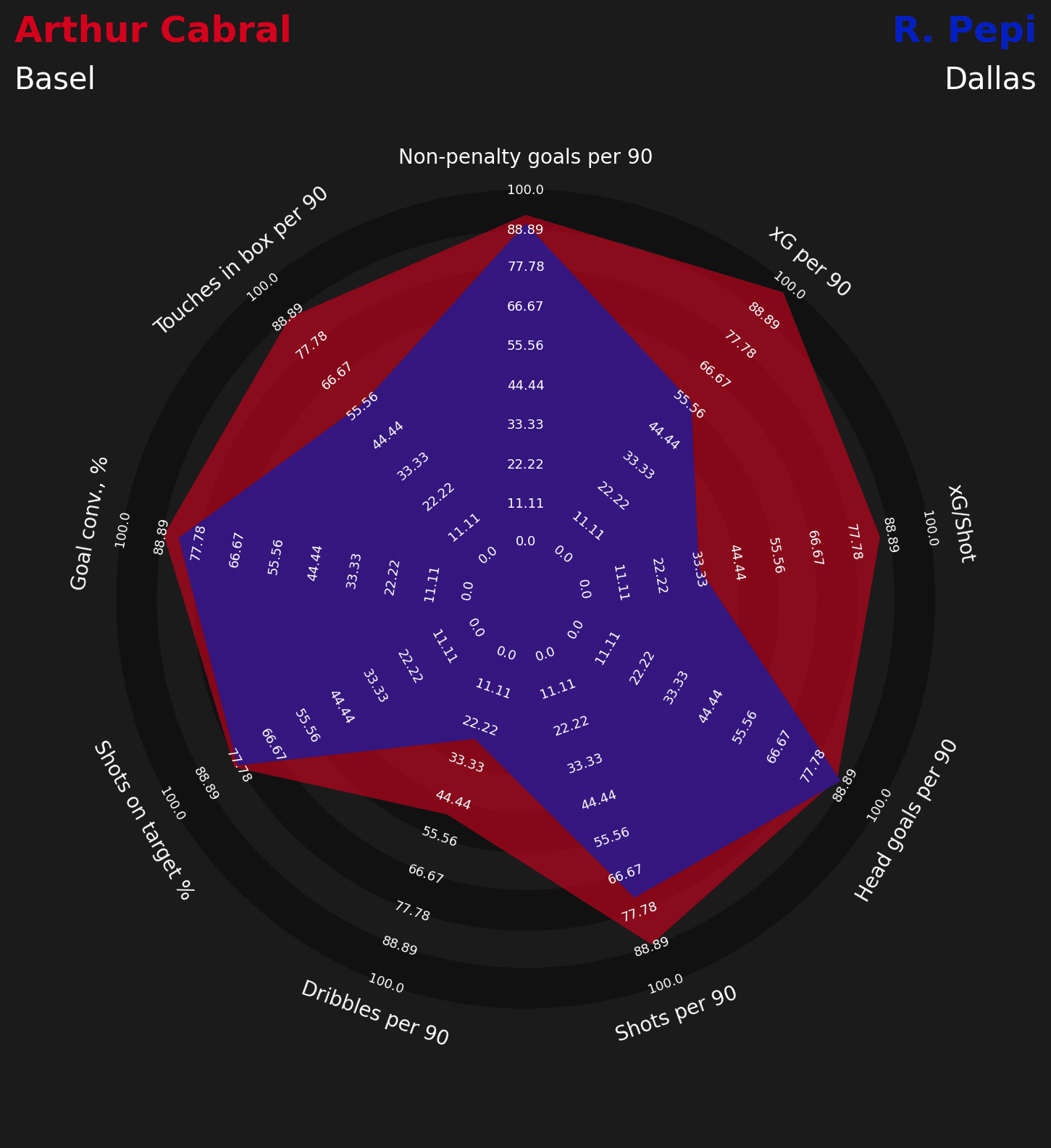
Pepi shares some obvious traits with Cabral but has big differences too. Both of them shoot a lot (2.52 shots per 90), also with their head, mostly on target (49.21%) and with a high conversion rate (20.64%). Pepi takes more speculative shots (0.14 xG per shot) and is less active both in the box (3.48 per 90) and with dribbles (1.96 per 90), probably because his team doesn’t dominate as much. However, the American is still scoring at one of the best rates in the MLS (0.52 non-penalty goals from 0.35 xG per 90), ranking similarly to Cabral in the Swiss Super League.
Pepi makes interesting runs in behind, creates spaces for himself and has a good pace thanks to his long legs. He has a good instinct to find spaces with good movements in the box and poach goals.
As in most young strikers, his finishing is inconsistent. He’s calm in 1v1 and usually does well and makes good decisions there but when he needs to shoot quickly from inside the box he has had good and bad streaks. Powerful to score with his head. His shot selection could be improved too as he has some attempts from far that aren’t his strength and also shoots into the rivals’ legs too often instead of trying to create space.
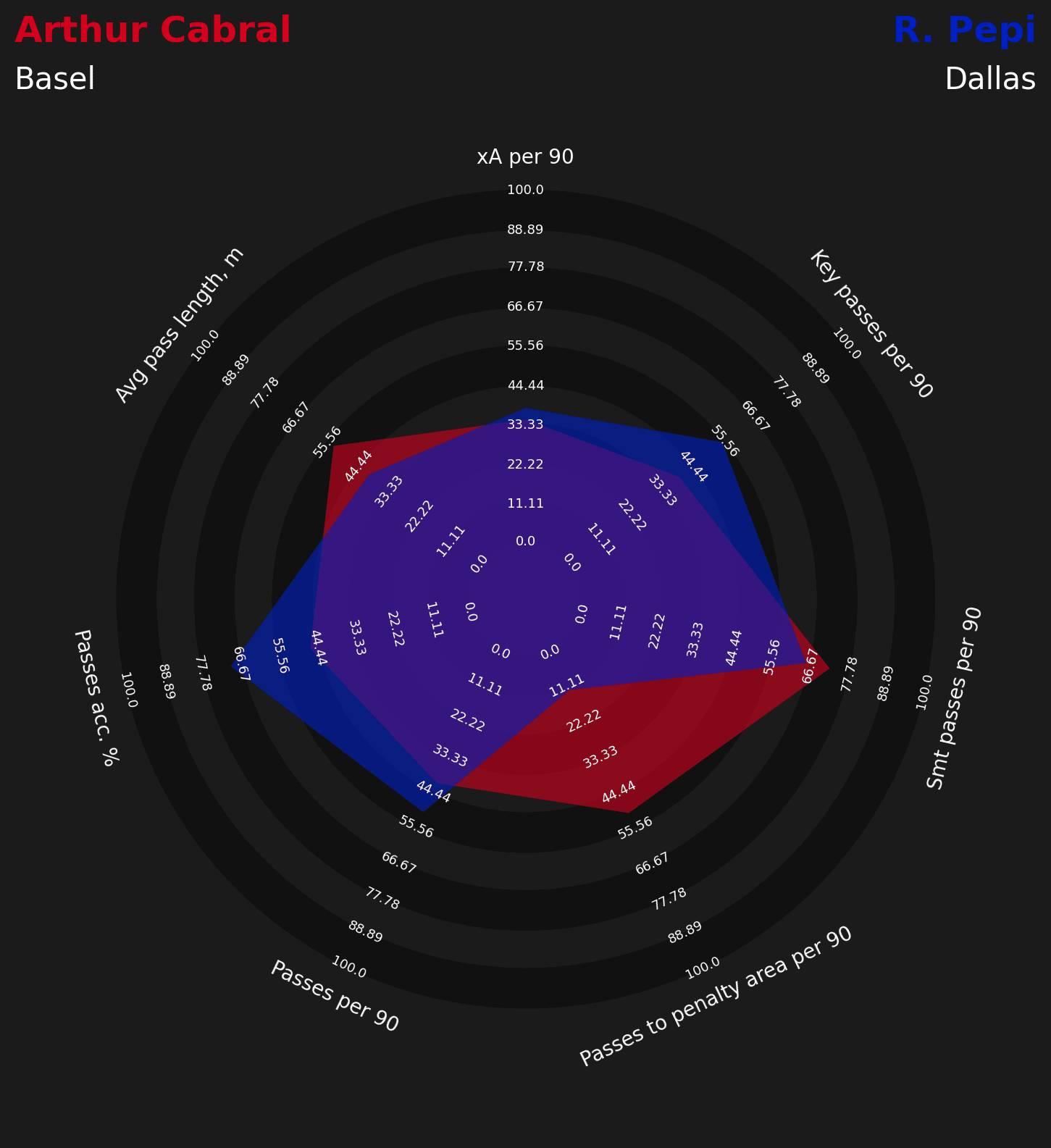
There are some interesting differences despite the general similarity in their passing profile. Pepi is more involved in the attacks, passing more the ball (19.62 passes per 90) and with higher accuracy (78.41%). He also creates more chances (0.4 key passes per 90) but overall their xA (0.07 xA per 90) is similar when compared to the strikers in their leagues. However, Cabral ranks much better in passes to the penalty area than Pepi (0.76 per 90).
Pepi drops between the lines to receive with his back to the goal and shows good technique to receive and pass. He usually plays short passes with intelligence and can combine effectively with players coming from the second line. After coming deep, he likes to run in behind and into the space he has generated by dragging a centre-back with him.
He doesn’t show special quality to assist with through balls or break down low blocks but it isn’t his role either and he does well sticking to his strengths and keeping the attacks fluid with his short passing.
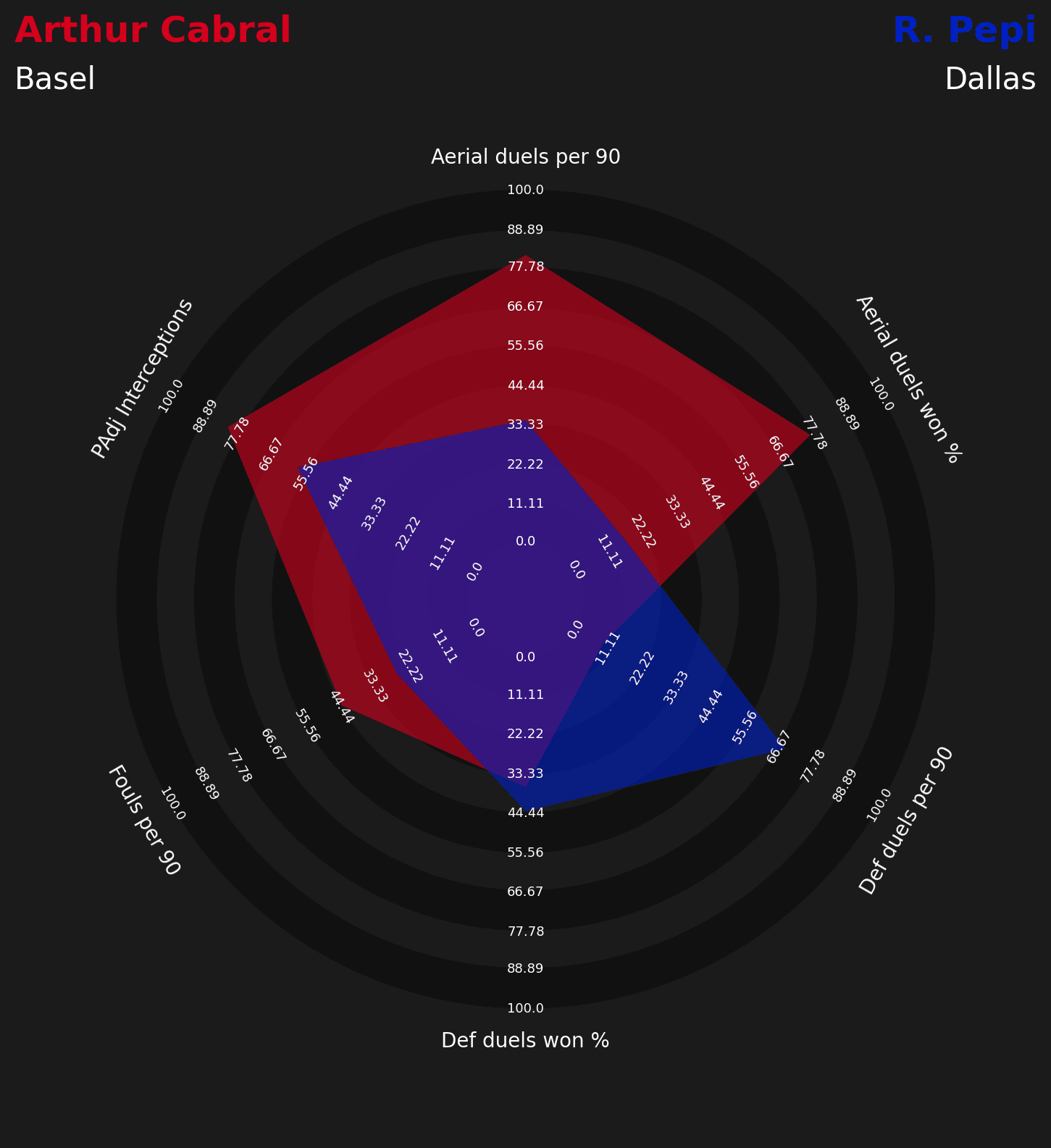
It’s in the defensive stats where they differ the most. Pepi isn’t very good in the air despite being tall as he needs to build some muscle given his age (wins just 23.29% of his 2.92 aerial duels per 90). He still works hard, gets into a lot of defensive duels (4.52 per 90) and wins a fair share of them (53.98%) without fouling the rival. He’s also quite good in possession adjusted interceptions (2.11 per 90) but not as good as Cabral.
A quite complete forward who combines size, pace, good movements and good technique to play with his back to the goal and combine. His scoring figures are outstanding for an 18-year-old striker despite his inconsistent finishing so there’s still room to grow and become an even more complete player.
If Barcelona want someone ready to perform from January, then Pepi would be a very risky move. He’s been doing great in the MLS but the step to La Liga is huge. If the idea is to bring someone young, ready to enjoy some minutes and with great potential, then he would be a very interesting choice as he can play for the U19 and B teams when he’s not with the first team and can be completely moulded to fit what Xavi expect from his number nine.
Conclusion
All the strikers we highlighted have a similar style, being focused on scoring goals and showing good presence upfront to be at the end of crosses and deep passes. They’re also proven goalscorers at their level. With Barcelona seemingly looking for a classical striker who has some physicality and whose main duty is to finish the attacks, these are valid options with high potential.
None of these players will offer Barcelona an immediate and riskless solution to their scoring problems and neither Cabral would. In their situation, it’s more about the right profile and someone they can get for a cheap fee and develop into a top player. There are alternatives in the market and choosing the right one could prove to be a vital decision for Barcelona.




Comments